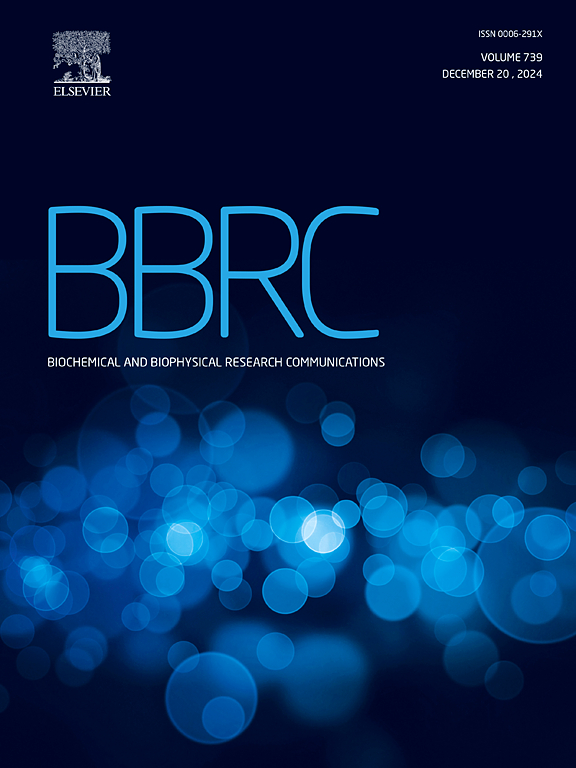OSGIN1 通过直接增强 GCLM 的活性来促进抗铁锈色素沉着。
IF 2.5
3区 生物学
Q3 BIOCHEMISTRY & MOLECULAR BIOLOGY
Biochemical and biophysical research communications
Pub Date : 2024-11-17
DOI:10.1016/j.bbrc.2024.151015
引用次数: 0
摘要
氧化应激诱导生长抑制因子 1(OSGIN1)是一种肿瘤蛋白 p53(TP53)靶基因,参与氧化应激反应并促进细胞凋亡。在这里,我们首次发现 OSGIN1 通过抑制铁凋亡反向发挥作用,铁凋亡是一种由过度脂质过氧化驱动的独特形式的氧化性细胞死亡。在人胰腺导管腺癌(PDAC)细胞中,OSGIN1的表达受药物性铁中毒诱导剂的上调,这种上调是以NFE2 like BZIP转录因子2(NFE2L2)依赖的方式进行的,而不是通过TP53途径。在体外和动物模型中,遗传性OSGIN1或NFE2L2的缺失同样会促进铁蛋白沉积,而OSGIN1的重新表达能挽救NFE2L2-敲除细胞的铁蛋白沉积抵抗。从机理上讲,免疫沉淀结合质谱分析发现,OSGIN1 与谷氨酸-半胱氨酸连接酶修饰亚基(GCLM)相互作用,增强了谷胱甘肽的生成,从而减轻了氧化应激。此外,OSGIN1 的表达与胰腺肿瘤中 NFE2L2 的表达呈正相关,而 NFE2L2 的表达与 PDAC 患者较差的预后有关。总之,这些发现建立了一种新的防御机制,它能调节铁蛋白沉积,并可能影响 PDAC 的肿瘤抑制。本文章由计算机程序翻译,如有差异,请以英文原文为准。
OSGIN1 promotes ferroptosis resistance by directly enhancing GCLM activity
Oxidative stress induced growth inhibitor 1 (OSGIN1) is a tumor protein p53 (TP53)-target gene involved in the oxidative stress response and promotes apoptosis. Here, we present the first evidence that OSGIN1 functions conversely by inhibiting ferroptosis, a distinct form of oxidative cell death driven by excessive lipid peroxidation. OSGIN1 expression is upregulated by pharmacological ferroptosis inducers in an NFE2 like BZIP transcription factor 2 (NFE2L2)-dependent manner, rather than through the TP53 pathway, in human pancreatic ductal adenocarcinoma (PDAC) cells. Genetic depletion of OSGIN1 or NFE2L2 similarly promotes ferroptosis, while re-expression of OSGIN1 rescues ferroptosis resistance in NFE2L2-knockout cells, both in vitro and in animal models. Mechanistically, immunoprecipitation combined with mass spectrometry revealed that OSGIN1 interacts with glutamate-cysteine ligase modifier subunit (GCLM), enhancing glutathione production and thereby mitigating oxidative stress. Additionally, OSGIN1 expression shows a positive correlation with NFE2L2 expression in pancreatic tumors, which is linked to poorer prognosis in PDAC patients. Collectively, these findings establish a novel defense mechanism that regulates ferroptosis and may influence tumor suppression in PDAC.
求助全文
通过发布文献求助,成功后即可免费获取论文全文。
去求助
来源期刊
CiteScore
6.10
自引率
0.00%
发文量
1400
审稿时长
14 days
期刊介绍:
Biochemical and Biophysical Research Communications is the premier international journal devoted to the very rapid dissemination of timely and significant experimental results in diverse fields of biological research. The development of the "Breakthroughs and Views" section brings the minireview format to the journal, and issues often contain collections of special interest manuscripts. BBRC is published weekly (52 issues/year).Research Areas now include: Biochemistry; biophysics; cell biology; developmental biology; immunology
; molecular biology; neurobiology; plant biology and proteomics

 求助内容:
求助内容: 应助结果提醒方式:
应助结果提醒方式:


